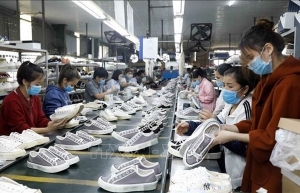More to come from landmark EU-Vietnam agreement
 |
| Dr. Nguyen Thai Chuyen - Lecturer in International Business RMIT University |
The agreement (EVFTA) also has clear regulations on the origin of goods to ensure transparent and fair trade. It opened up opportunities for Vietnam to access advanced tech and knowledge from the EU, creating better conditions for technology transfer and the modernisation of manufacturing industries.
The agreement also affects many other areas, such as intellectual property protection, reduction of customs clearance procedures, environmental protection, government procurement, and dispute resolution.
Despite many disruptions since 2020, export turnover from Vietnam to the EU has experienced growth, with on-year increases of 14.2 per cent in 2021 and 16.7 per cent in 2022.
Many products have been quite successful in taking advantage of the benefits from the agreement. Items with annual export turnover of more than $1 billion to the EU market during the past three years include phones and components; computers; footwear; machinery; equipment and other spare parts; textiles and garments; coffee; iron and steel; and seafood. However, phones and components recorded an on-year decrease of 9.5 per cent in 2021 and 15.7 per cent in 2022, respectively.
Overall, Vietnamese enterprises have derived limited value and benefits from export activities because Vietnamese brands are not yet widely known in European countries. The share of Vietnamese goods in the EU’s imports is only 2 per cent, according to Trading Economics.
Some of Vietnam’s key export products have not performed as well as expected in this market. Vegetables, seafood and rice are a few examples. Despite good growth, these items currently represent only a minimal part of the total value of the EU’s imports for such items.
In addition, a number of commodities have not shown signs of growth after the agreement came into effect, such as paper, paper products, and cashew.
Meanwhile, Vietnamese companies still encounter many difficulties in complying with the rules of origin under the agreement. For agricultural and forestry products, producers and traders must prove that the product is legal and does not violate regulations on deforestation.
Moreover, for nearly six years now, Vietnamese seafood has been subject to the illegal, unreported, and unregulated yellow card by the European Commission, making seafood exports difficult. Benefits will not be fully utilised while the yellow card still exists.
The EU is a demanding market with strict quality standards and safety requirements for industrial goods, as well as hygiene and quarantine standards for imported agricultural products and food. These pose another obstacle for Vietnamese enterprises because most of the raw materials for the production of goods in Vietnam are imported from China and other ASEAN countries, making it difficult to control quality standards.
Many Vietnamese enterprises have yet to be proactive in exploring and taking advantage of the benefits from the EVFTA.
According to a survey by the Vietnam Chamber of Commerce and Industry on the awareness of EVFTA among businesses, nearly 94 per cent of respondents have heard of or know about the EVFTA, but only around 40 per cent of those understand well or quite well how the commitments affect their business. Foreign-invested enterprises have the highest rate of awareness at 43 per cent.
Europe is a fastidious market with very strict product standards, so Vietnamese businesses wanting to access this market will need to make efforts to change and adapt, and take full advantage of support from the authorities and associations.
Businesses should actively acquire knowledge and improve their understanding of EU standards and regulations. They can seek support from the authorities, especially via government-led programmes to support raising business competitiveness. In addition, it is necessary to strengthen cooperation and linkages between enterprises, especially through associations. This will enable enterprises to share knowledge and techniques, and expand their distribution networks, thereby raising their competitiveness in the EU market.
For export businesses in particular, they will need to raise the quality of their products and services, while adopting the high safety and environmental protection standards required by the EU. They should also diversify their customer base and reduce the risks from depending on a single export market. It is important that they follow consumer trends and apply more creativity in doing business, while maintaining direct, continuous and fast-paced interactions with customers.
 | Exporters urged to meet EU trade deal regulations Despite the EU-Vietnam Free Trade Agreement’s eradication of tariffs for many export items into the EU market, meeting strict rules of origin continue to be a burden for firms to cash in on the deal’s benefits. |
 | Smooth progress bodes well for EVFTA In the three years since the EU-Vietnam Free Trade Agreement entered into force, notable growth in bilateral exports between both sides has been evident. Jean-Jacques Bouflet, vice chairman of advocacy at the European Chamber of Commerce in Vietnam (EuroCham), talked to VIR’s Luu Huong on the agreement’s impact on trade and investment dynamics, and offered insight into key strategies for the evolving economic relationship. |
What the stars mean:
★ Poor ★ ★ Promising ★★★ Good ★★★★ Very good ★★★★★ Exceptional
Related Contents
Latest News
More News
- Main drivers for Vietnam’s digital economy future (December 03, 2025 | 11:35)
- Pivotal stage of growth paves way for rise in M&As (December 03, 2025 | 10:00)
- Positive projections for M&A interest from Thailand (December 03, 2025 | 09:40)
- Manifesting the first line of defence in cybersecurity (December 03, 2025 | 09:00)
- The transformational role AI can play in accounting arena (December 03, 2025 | 08:00)
- Unlocking 5G-AI potential in Singapore (December 03, 2025 | 08:00)
- Data-driven strategies vital for a fast-evolving nation (December 02, 2025 | 09:41)
- Policy to practice: how Vietnam can lead the region (November 26, 2025 | 16:03)
- Mobilising private capital at scale vital for climate battle (November 26, 2025 | 15:36)
- VILAF and Yoon & Yang launch Vietnam - Korea Practice Unit (November 26, 2025 | 15:16)

 Tag:
Tag:





















 Mobile Version
Mobile Version